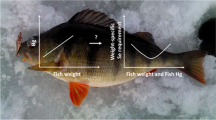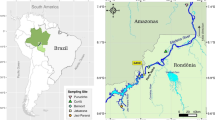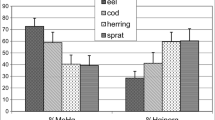Abstract
Background, aim, and scope
Selenium (Se) has been shown to reduce mercury (Hg) bioavailability and trophic transfer in aquatic ecosystems. The study of methylmercury (MeHg) and Se bioaccumulation by plankton is therefore of great significance in order to obtain a better understanding of the estuarine processes concerning Hg and Se accumulation and biomagnification throughout the food web. In the western South Atlantic, few studies have documented trace element and MeHg in fish tissues. No previous study about trace elements and MeHg in plankton has been conducted concerning tropical marine food webs. Se, Hg, and MeHg were determined in two size classes of plankton, microplankton (70–290 μm) and mesoplankton (≥290 μm), and also in muscle tissues and livers of four fish species of different trophic levels (Mugil liza, a planktivorous fish; Bagre spp., an omnivorous fish; Micropogonias furnieri, a benthic carnivorous fish; and Centropomus undecimalis, a pelagic carnivorous fish) from a polluted estuary in the Brazilian Southeast coast, Guanabara Bay. Biological and ecological factors such as body length, feeding habits, and trophic transfer were considered in order to outline the relationships between these two elements. The differences in trace element levels among the different trophic levels were investigated.
Materials and methods
Fish were collected from July 2004 to August 2005 at Guanabara Bay. Plankton was collected from six locations within the bay in August 2005. Total mercury (THg) was determined by cold vapor atomic absorption spectrometry (CV-AAS) with sodium borohydride as a reducing agent. MeHg analysis was conducted by digesting samples with an alcoholic potassium hydroxide solution followed by dithizone-toluene extraction. MeHg was then identified and quantified in the toluene layer by gas chromatography with an electron capture detector (GC-ECD). Se was determined by AAS using graphite tube with Pin platform and Zeeman background correction.
Results and discussion
Total mercury, MeHg, and Se increased with plankton size class. THg and Se values were below 2.0 and 4.8 μg g−1 dry wt in microplankton and mesoplankton, respectively. A large excess of molar concentrations of Se in relation to THg was observed in both plankton size class and both fish tissues. Plankton presented the lowest concentrations of this element. In fish, the liver showed the highest THg and Se concentrations. THg and Se in muscle were higher in Centropomus undecimalis (3.4 and 25.5 nmol g−1) than in Micropogonias furnieri (2.9 and 15.3 nmol g−1), Bagre spp (1.3 and 3.4 nmol g−1) and Mugil liza (0.3 and 5.1 nmol g−1), respectively. The trophic transfer of THg and Se was observed between trophic levels from prey (considering microplankton and mesoplankton) to top predator (fish). The top predators in this ecosystem, Centropomus undecimalis and Micropogonias furnieri, presented similar MeHg concentrations in muscles and liver. Microplankton presented lower ratios of methylmercury to total mercury concentration (MeHg/THg) (34%) than those found in mesoplankton (69%) and in the muscle of planktivorous fish, Mugil liza (56%). The other fish species presented similar MeHg/THg in muscle tissue (of around 100%). M. liza showed lower MeHg/THg in the liver than C. undecimalis (35%), M. furnieri (31%) and Bagre spp. (22%). Significant positive linear relationships were observed between the molar concentrations of THg and Se in the muscle tissue of M. furnieri and M. liza. These fish species also showed significant inverse linear relationships between hepatic MeHg and Se, suggesting a strong antagonistic effect of Se on MeHg assimilation and accumulation.
Conclusions
Differences found among the concentrations THg, MeHg, and Se in microplankton, mesozooplankton, and fishes were probably related to the preferred prey and bioavailability of these elements in the marine environment. The increasing concentration of MeHg and Se at successively higher trophic levels of the food web of Guanabara Bay corresponds to a transfer between trophic levels from the lower trophic level to the top-level predator, suggesting that MeHg and Se were biomagnified throughout the food web. Hg and Se were positively correlated with the fish standard length, suggesting that larger and older fish bioaccumulated more of these trace elements. THg, MeHg, and Se were a function of the plankton size.
Recommendations and perspectives
There is a need to assess the role of selenium in mercury accumulation in tropical ecosystems. Without further studies of the speciation of selenium in livers of fishes from this region, the precise role of this element, if any, cannot be verified in positively affecting mercury accumulation. Further studies of this element in the study of marine species should include liver samples containing relatively high concentrations of mercury. A basin-wide survey of selenium in fishes is also recommended.



Similar content being viewed by others
References
Andersen JL, Depledge MH (1997) A survey of total mercury and methylmercury in edible fish and invertebrates from Azorean waters. Mar Pollut Bull 44:331–350
Baldwin S, Maher W, Kleber E, Krikowa F (1996) Selenium in marine organisms of seagrass habitats (Posidonia australis) of Jervis Bay, Australia. Mar Pollut Bull 32:310–316
Baêta AP, Kehrig HA, Malm O, Moreira I (2006) Total mercury and methylmercury in fish from a tropical estuary. In: Kungolos A, Brebbia CA, Samaras CP, Popov V (eds) Environmental toxicology. Wit, Southampton, Boston, pp 183–192
Bargagli R, Monaci F, Sanches-Hernandez JC, Catemi D (1998) Biomagnification of mercury in an Antarctic marine coastal food web. Mar Ecol Prog Ser 169:65–76
Barwick M, Maher W (2003) Biotransference and biomagnification of selenium, copper, cadmium, zinc, arsenic and lead in a temperate seagrass ecosystem from Lake Macquarie Estuary, NSW, Australia. Mar Environ Res 56:471–502
Bjerregaard P, Andersen BW, Rankin JC (1999) Retention of methylmercury and inorganic mercury in rainbow trout Oncorhynchus mykiss (W): effect of dietary selenium. Aquat Toxicol 45:171–180
Bhattacharya B, Sarkar SK, Das R (2003) Seasonal variations and inherent variability of selenium in marine biota of a tropical wetland ecosystem: implications for bioindicators species. Ecological Indicators 2:367–375
Boisson F, Romeo M (1996) Selenium in plankton from the northwestern Mediterranean sea. Water Res 30(11):2593–2600
Capelli R, Drava G, De Pellegrini R, Minganti V, Poggi R (2000) Study of trace elements in organs and tissues of striped dolphins (Stenella coeruleoalba) found dead along the Ligurian coasts (Italy). Adv Environ Res 4:31–45
Chen Y-W, Belzile N, Gunn JM (2001) Antagonistic effect of selenium on mercury assimilation by fish populations near Sudbury metal smelters. Limnol Oceanogr 46(7):1814–1818
Costa M, Barletta M, Silva OCA (2004) Fish species as indicators of chemical pollution in a tropical estuary. Anais do IV International Congress on the Biology of Fish, Manaus, AM, Brazil
Dietz R, Riget F, Born EW (2000) An assessment of selenium to mercury in Greenland marine animals. Sci Total Environ 245:15–24
Fabris G, Turoczy NJ, Stagnitti F (2006) Trace metal concentrations in edible tissue of snapper, flathead, lobster, and abalone from coastal waters of Victoria, Australia. Ecotoxicol Environ Saf 63:286–292
Fisher NS, Reinfelder JR (1995) The trophic transfer of metals in marine system. In: Tessier A, Turner DR (eds) Metal speciation and bioavailability in aquatic systems. Wiley, Chichester, pp 363–406
Frodello JP, Roméo M, Viale D (2000) Distribution of mercury in the organs and tissues of five toothed-whale species of the Mediterranean. Environ Pollut 108:447–452
Grasshoff K, Ehrhardt M, Kremling K (1983) Methods of seawater analysis, 2nd edn. Verlag Chemie, Weinheim, p 419
Hamilton SJ (2004) Review of selenium toxicity in the aquatic food chain. Sci Total Environ 326:1–31
Harris R, Kidd K, Shanley J (2008) Bridging the knowledge gaps on the sources, speciation, fate and bioaccumulation of mercury in aquatic and terrestrial environments. Environ Pollut 154(1):1–2
Ikemoto T, Kunito T, Watanabe I, Yasunaga G, Baba N, Miyazaki N, Petrov EA, Tanabe S (2004) Comparison of trace element accumulation in Baikal seals (Pusa sibirica), Caspian seals (Pusa caspica) and northern fur seals (Callorhinus ursinus). Environ Pollut 127:83–97
Jablonski S, Azevedo AF, Moreira LHA (2006) Fisheries and conflicts in Guanabara Bay, Rio de Janeiro, Brazil. Braz Arch Biol Technol 49(1):79–91
Jin L, Liang L, Jiang G, Xu Y (2006) Methylmercury, total mercury and total selenium in four common freshwater fish species from Ya-Er Lake, China. Environ Geochem Health 28(5):401–407
Joiris CR, Holsbeek L, Moatemri NL (1999) Total and organic mercury in sardines Sardinella aurita and Sardina pilchardus from Tunisia. Mar Pollut Bull 38(3):188–192
Joiris CR, Holsbeek L, Bolba D, Gascard C, Stanev T, Komakhidzes A, Baumgärtner W, Birkun A (2001) Total and organic mercury in the Black Sea Harbour Porpoise Phocoena phocoena relicta. Mar Pollut Bull 42(10):905–911
Kainz M, Mazumder A (2005) Effect of algal and bacterial diet on methyl mercury concentrations in zooplankton. Environ Sci Technol 39:1666–1672
Kehrig HA, Malm O, Moreira I (1998) Mercury in a widely consumed fish Micropogonias furnieri (Demarest, 1823) from four main Brazilian estuaries. Sci Total Environ 213:263–271
Kehrig HA, Costa M, Moreira I, Malm O (2001) Methylmercury and total mercury in estuarine organisms from Rio de Janeiro-Brazil. Environ Sci Pollut Res 8(4):275–279
Kehrig HA, Seixas TG, Baeta A, Lailson-Brito J, Moreira I, Malm O (2004) Total mercury, methylmercury and selenium in the livers and muscle of different fishes and a marine mammal from a tropical estuary-Brazil. RMZ-Materials and Geoenvironment 51(1):1111–1114
Kehrig HA, Costa M, Moreira I, Malm O (2006) Total and methyl mercury in different species of mollusks from two estuaries in Rio de Janeiro State. J Braz Chem Soc 17(7):1409–1418
Kehrig HA, Seixas TG, Palermo EA, Di Beneditto APM, Souza CMM, Malm O (2008) Different species of mercury in the livers of tropical dolphins. Anal Lett 41(9):1691–1699
Kjerfve B, Ribeiro CHA, Dias GTM, Filippo AM, Quaresma VS (1997) Oceanographic characteristics of an impacted coastal bay: Baia de Guanabara, Rio de Janeiro, Brazil. Cont Shelf Res 17(13):1609–1643
Kojadinovic J, Potier M, Le Corre M, Cosson RP, Bustamante P (2007) Bioaccumulation of trace elements in pelagic fish from the Western Indian Ocean. Environ Pollut 146:548–566
Lawson NM, Mason RP (1998) Accumulation of mercury in estuarine food chains. Biogeochemistry 40:235–247
Lemly AD (1999) Selenium transport and bioaccumulation in aquatic Ecosystems: a proposal for water quality criteria based on hydrological units. Ecotoxicol Environ Saf 42:150–156
Lindqvist O, Johnasson K, Aastrup M, Andersson A, Bringmark L, Hovsenius G, Håkanson Å, Meili M, Timm B (1991) Mercury in the Swedish environment-recent research on causes, consequences and corrective methods. Water Air Soil Pollut 55:1–251
Mason RP, Laporte J-M, Andres S (2000) Factors controlling the bioaccumulation of mercury, methylmercury, arsenic, selenium, and cadmium by freshwater invertebrates and fish. Arch Environ Contam Toxicol 38:283–297
Maher W, Baldwin S, Deaker M, Irving M (1992) Characteristics of selenium in Australian marine biota. Appl Organomet Chem 6(2):103–112
Mikac N, Picer M, Stegnar P, Tusec-Znidaric M (1985) Mercury distribution in a polluted marine area, ratio of total mercury, methyl mercury and selenium in sediments, mussels and fish. Water Res 19:1397–1392
Nigro M, Leonzio C (1996) Intracellular storage of mercury and selenium in different marine invertebrates. Mar Ecol Prog Ser 135:137–143
Peters GM, Maher WA, Krikowa F, Roach AC, Jeswani HK, Barford JP, Gomes VG, Reible DD (1999) Selenium in sediments, pore water and benthic in fauna of Lake Macquarie, New South Wales, Australia. Mar Environ Res 47:491–508
Purkerson DG, Doblin MA, Bollens SM, Luoma SN, Cutter G (2003) Selenium in San Francisco Bay zooplankton: potential effects of hydrodynamics and food web interaction. Estuaries 26(4A):956–969
Reinfelder JR, Fisher NS, Luoma SN, Nichols JW, Wang W-X (1998) Trace element trophic transfer in aquatic organisms: a critique of the kinetic model approach. Sci Total Environ 219:117–135
Seixas TG, Kehrig HA, Moreira I, Malm O (2007) Distribuição de Selênio em Organismos Marinhos da Baía de Guanabara, RJ. Quim Nova 30(3):554–559
Stewart AR, Luoma SN, Schlekat CE, Doblin MA, Hieb KA (2004) Food web pathway determines how selenium affects aquatic ecosystems: a San Francisco Bay case study. Environ Sci Technol 38:4519–4526
Strickland JDH, Parsons TR (1972) A practical handbook of seawater analysis. Fisheries Research Board of Canada, vol. 167, 311 pp
Turner MA, Rudd JWM (1983) The English Wabigoon River System III: selenium in lake enclosures, its geochemistry, bioaccumulation and ability to reduce mercury bioaccumulation. Can J Fish Aquat Sci 40:2228–2240
Turner MA, Swick AL (1983) The English Wabigoon River System: interaction between mercury and selenium accumulated from waterborne and dietary sources by northern pike. Can J Fish Aquat Sci 40:2241–2250
Valentin JL, Tenebaum DR, Bonecker ACT, Bonecker SLC, Nogueira CR, Villac MC (1999) O sistema planctônico da Baía da Guanabara: síntese do conhecimento. Oecologia Brasiliensis 3:35–39
Varanasi U, Stein JE, Tilbury KL, Meador JP, Sloan CA, Clark RC, Chan SL (1994) Chemical contaminants in gray whales (Eschrichtius robustus) stranded along the west coast of North America. Sci Total Environ 145:29–53
Wagemann R, Trebacs E, Boila G, Lockhart WL (2000) Mercury species in the liver of ringed seals. Sci Total Environ 261:21–32
Wang W-X, Fisher NS (1998) Accumulation of trace elements in a marine copepod. Limnol Oceanogr 43(2):273–283
Watras CJ, Back RC, Halvorsen S, Hudson RJM, Morrison KA, Wente SP (1998) Bioaccumulation of mercury in pelagic freshwater food webs. Sci Total Environ 219:183–208
WHO (1989) Mercury. Environmental aspects Criteria N° 86. World Health Organization, Geneva, Switzerland
Zhang X, Naidu AS, Kelley J, Jewett SC, Dasher D, Duffy LK (2001) Baseline concentrations of total and methylmercury in salmon returning via the Bering Sea (1999–2000). Mar Pollut Bull 42:993–997
Acknowledgments
The authors would like to extend their thanks for the financial support of the Conselho Nacional de Desenvolvimento Científico e Tecnológico (CNPq Proc 476735/2003-3). We are also grateful to the Fundação de Amparo à Pesquisa do Estado do Rio de Janeiro (FAPERJ Proc 170998/2002) for the grant to Dr Helena do A. Kehrig's Post-doctoral Project “O Papel do Selênio na Acumulação e Biomagnificação do Metilmercúrio ao Longo da Cadeia Alimentar da Baía de Guanabara”. Special thanks to Dr. Monica F. Costa for the useful suggestions in the preparation of the manuscript and to Rachel Hauser Davis for her assistance in providing this English version.
Author information
Authors and Affiliations
Corresponding author
Additional information
Responsible editor: Lee Young
Rights and permissions
About this article
Cite this article
Kehrig, H.A., Seixas, T.G., Palermo, E.A. et al. The relationships between mercury and selenium in plankton and fish from a tropical food web. Environ Sci Pollut Res 16, 10–24 (2009). https://doi.org/10.1007/s11356-008-0038-8
Received:
Accepted:
Published:
Issue Date:
DOI: https://doi.org/10.1007/s11356-008-0038-8




